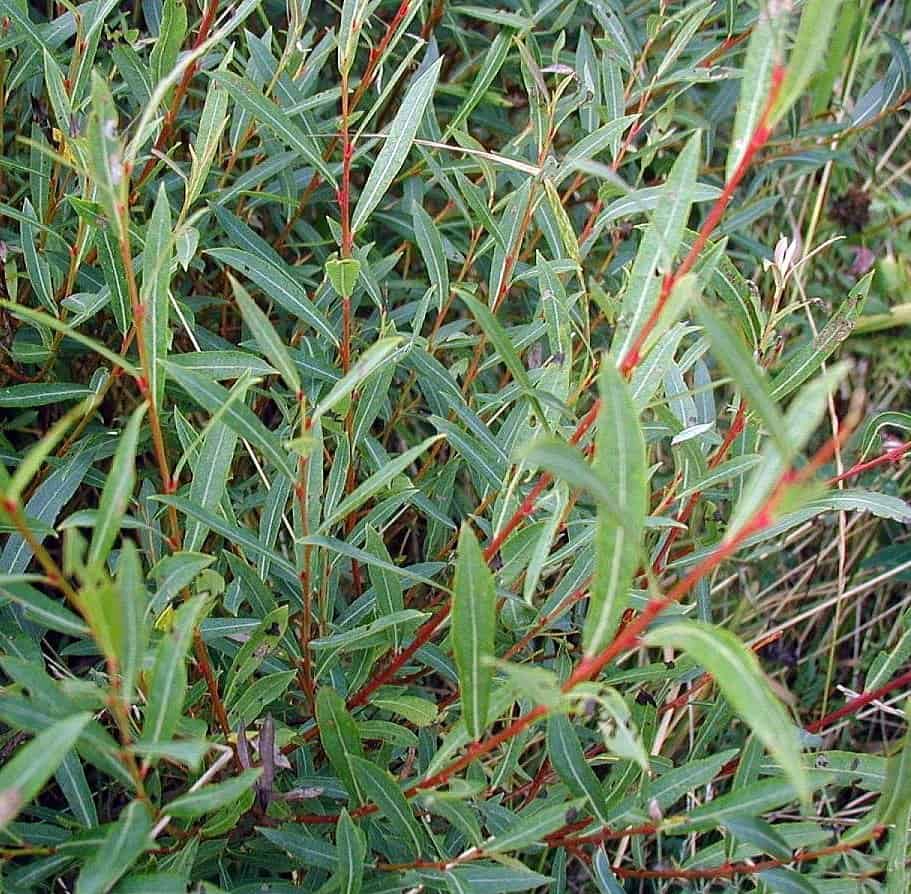
I’m interested in useful plants that serve practical purposes, and who wouldn’t be? These may not be beautiful or irresistible, but they’re still attractive and solve a problem. Cedar shrubs are a good example. Consider how they can serve as a privacy hedge, frame a doorway or make a garden boundary.
The useful plant I have in mind today is Arctic blue-leaf willow (Salix purpurea ‘Nana’, syn. S. f. gracilis, Zone 4), a dwarf cultivar of purple osier or basket willow (Salix purpurea). The mature parent plant is 12 x 12 feet (3.5 x 3.5 m) with thin, flexible branches that have been used for centuries for basket making. Fortunately, the dwarf cultivar ‘Nana’ (4 ft. x 40 in. / 1.2 x 1 m) is a mere whisper of the mother’s girth. Its thin stems are strongly vertical and bear a haze of narrow blue-green leaves. The supple quality of the stems allows wind to ruffle through the leaves, a great part of its charm. Three shrubs clustered together make a pleasing display, with the sun enhancing their blue-green colour and wind swishing them around like mermaid hair.
Arctic blue-leaf willow is tall enough to stand at the back of a border, and makes an attractive companion for shrub roses and climbing roses. Its blue-green colour enhances flowering shrubs like mock orange and hydrangea. One shrub could soften the corner of a garage or a pair could frame a garden gate. Of course, it’s a perfect companion to conifers, its soft sway contrasting with their more rigid forms. In a relaxed landscape, it makes a logical association with tall ornamental grasses and clumps of perennial flowers. As a temporary seasonal plant, Arctic blue-leaf willow looks terrific in a large container with grey and white cascading annuals spilling down the sides.
Willows of all kinds are known for their affinity to moisture, so it’s no surprise that ‘Nana’ becomes a straggly mess in dry soil, but it will be serenely graceful in sun to part shade areas that receive regular irrigation. The trick to keeping it in good form is to allow it to grow through spring and summer without pruning it. Every autumn, cut all stems back to 10 inches (20 cm) above ground. Attempting to flat-top or shape it during the growing season will only ruin its natural form. In spring, the new bark will be attractively dark red-purple, and then turn to grey-olive green, soon to be spangled with narrow blue-green leaves.
And that’s what I call a useful plant!
Other posts by Judith this week:
Posts by Judith last week:

I planted dwarf arctic blue willow shrubs 2 months ago (Illinois) and today I noticed branches are falling off the little shrubs. What do I need to do. they are starting to look scrawny. Why is this happened ?
What I have found so far with mine is it’s plant shock. Mine looked AMAZING going into the ground over the summer. But when we started having really hot days they didn’t take it well. And it seemed like I couldn’t water them enough. Then it cooled back down a bit and they started doing better. We are just heading into our cold season so I will be able to trim them back and start shaping them for spring. And I fertilize one more time before they go totally dormant.
There are red lumps growing on my blue artic plant. Is this the flower or a disease.